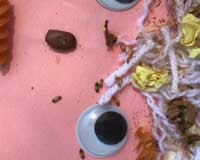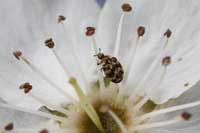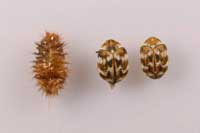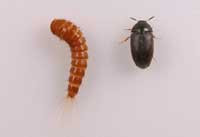Carpet beetles, those tiny household pests, can indeed travel from house to house. SIXT.VN offers expert advice and travel solutions, ensuring a comfortable and pest-free experience during your Vietnam visit. Understanding their habits and implementing preventive measures is crucial for maintaining a pest-free environment in your home and during your travels.
1. What Are Carpet Beetles And Why Should You Care?
Carpet beetles are small insects that belong to the family Dermestidae, known for their ability to damage fabrics, carpets, and other household items. Caring about them is essential because their larvae feed on natural fibers, causing significant damage to clothing, upholstery, and even stored food.
1.1. Identifying Carpet Beetles
Identifying carpet beetles early can save you a lot of trouble. Here’s what to look for:
- Adults: Small, oval-shaped beetles, typically 1/8 to 3/16 inch long. Varied carpet beetles have mottled patterns of white, brown, and yellow scales, while black carpet beetles are shiny black or dark brown.
- Larvae: Resemble small, hairy worms, ranging from light brown to almost black. They have a carrot-like shape, with bristles or hairs covering their bodies.
 Varied carpet beetle larvae infesting a child?s art project made out of yarn, noodles, and beans.
Varied carpet beetle larvae infesting a child?s art project made out of yarn, noodles, and beans.
1.2. Common Signs of Infestation
Catching an infestation early is vital. Look out for these signs:
- Damage to fabrics: Irregular holes in clothing, carpets, upholstery, and other textiles.
- Shed skins: Larval cast skins that resemble small, brown shells.
- Live beetles or larvae: Spotting the pests themselves is a clear indication of an infestation.
- Fecal pellets: Tiny, salt-like droppings in infested areas.
1.3. Types of Carpet Beetles in Homes
Several species of carpet beetles can invade your home. Here are the most common ones:
- Varied Carpet Beetle (Anthrenus verbasci): Known for its irregular pattern of scales and the larvae’s distinctive tufts of hair.
- Furniture Carpet Beetle (Anthrenus flavipes): Slightly larger and rounder than the varied carpet beetle, with a mottled appearance.
- Black Carpet Beetle (Attagenus unicolor): Shiny black or dark brown adults with smooth, tapered larvae.
2. How Do Carpet Beetles Travel? Understanding Their Mobility
Carpet beetles are surprisingly mobile, and understanding how they travel is key to preventing infestations.
2.1. Flight Capabilities of Adult Carpet Beetles
Adult carpet beetles can fly, allowing them to move from place to place with relative ease. They are attracted to light and can often be found near windows.
2.2. Hitchhiking on Items Brought Indoors
Carpet beetles can hitch a ride into your home on various items:
- Cut flowers: Adult beetles may be feeding on pollen and nectar and get brought inside with the flowers.
- Used furniture: Infested furniture can introduce carpet beetles into your home.
- Clothing and luggage: Beetles or larvae can hide in fabrics and be transported from one location to another.
- Packages: Beetles can enter your home through infested cardboard boxes or packaging materials.
2.3. Movement Between Buildings
Carpet beetles can move between buildings, especially in close proximity. This is more common in apartments or townhouses.
2.4. Seasonal Migration Patterns
Carpet beetles often exhibit seasonal migration patterns, with adults becoming more active in the spring and summer as they seek out mates and new food sources.
3. Factors That Attract Carpet Beetles To Your Home
Understanding what attracts carpet beetles to your home can help you take preventive measures.
3.1. Food Sources: Natural Fibers And Organic Materials
Carpet beetles are attracted to homes that provide ample food sources for their larvae. These include:
- Wool: Carpets, rugs, clothing, and upholstery made from wool.
- Silk: Clothing, bedding, and decorative items made from silk.
- Leather: Leather clothing, furniture, and accessories.
- Fur: Fur coats, stoles, and other fur items.
- Feathers: Feather pillows, comforters, and decorative items.
- Hair: Pet hair, human hair, and hair-filled furniture stuffing.
- Stored food: Grains, cereals, and spices in pantries.
3.2. Dark, Undisturbed Areas
Carpet beetle larvae prefer dark, undisturbed areas where they can feed without being disturbed.
3.3. Accumulation of Dust, Lint, and Debris
Accumulations of dust, lint, and debris provide a breeding ground for carpet beetles, as they contain organic matter that larvae can feed on.
3.4. Presence of Bird Nests, Rodent Nests, or Insect Collections
Bird nests, rodent nests, and insect collections can harbor carpet beetles, providing them with a continuous food source and a place to breed.
4. Preventive Measures To Keep Carpet Beetles Out
Keeping carpet beetles out requires a combination of vigilance, good housekeeping, and preventive measures.
4.1. Seal Cracks And Openings In Your Home’s Foundation And Exterior
Sealing cracks and openings in your home’s foundation and exterior can prevent carpet beetles from entering.
4.2. Install Or Repair Window And Door Screens
Installing or repairing window and door screens can keep adult carpet beetles from flying into your home.
4.3. Regular Cleaning: Vacuuming, Dusting, and Decluttering
Regular cleaning is one of the most effective ways to prevent carpet beetle infestations.
- Vacuuming: Vacuum carpets, rugs, upholstery, and other textiles regularly to remove eggs, larvae, and adults.
- Dusting: Dust surfaces to remove lint, hair, and other debris that carpet beetles can feed on.
- Decluttering: Reduce clutter to eliminate hiding places for carpet beetles.
4.4. Proper Storage Of Clothing And Textiles
Proper storage of clothing and textiles can prevent carpet beetles from accessing them.
- Laundering or dry cleaning: Wash or dry clean clothing and textiles before storing them.
- Airtight containers: Store items in airtight containers to protect them from carpet beetles.
- Mothballs or cedar chips: Use mothballs or cedar chips to repel carpet beetles.
4.5. Inspecting Items Before Bringing Them Indoors
Always inspect items before bringing them indoors.
- Cut flowers: Check cut flowers for adult beetles before bringing them inside.
- Used furniture: Inspect used furniture for signs of infestation before bringing it into your home.
- Clothing and luggage: Check clothing and luggage for beetles or larvae after traveling.
4.6. Using Pheromone Traps For Monitoring
Pheromone traps can be used to monitor carpet beetle populations and detect infestations early.
 Adult varied carpet beetle on a flower.
Adult varied carpet beetle on a flower.
5. What To Do If You Find Carpet Beetles In Your Home
If you find carpet beetles in your home, take immediate action to eliminate the infestation and prevent further damage.
5.1. Thorough Inspection To Identify Infested Areas
Conduct a thorough inspection to identify all infested areas.
- Check carpets, rugs, and upholstery.
- Inspect clothing and textiles.
- Look in closets and storage areas.
- Check for shed skins and fecal pellets.
5.2. Cleaning Infested Items And Areas
Clean infested items and areas thoroughly.
- Vacuum: Vacuum all infested areas to remove eggs, larvae, and adults.
- Launder or dry clean: Wash or dry clean infested clothing and textiles.
- Steam cleaning: Steam clean carpets, rugs, and upholstery to kill carpet beetles and their eggs.
5.3. Insecticide Treatments: When And How To Use Them
Insecticide treatments can be used to control carpet beetle infestations, but they should be used judiciously.
- Spot treatments: Apply insecticides as spot treatments to infested areas.
- Crack and crevice treatments: Apply insecticides to cracks and crevices where carpet beetles may be hiding.
- Professional pest control: Consider hiring a professional pest control service for severe infestations.
5.4. Natural Remedies: Diatomaceous Earth And Essential Oils
Natural remedies can be used to control carpet beetle infestations without resorting to harsh chemicals.
- Diatomaceous earth: Apply diatomaceous earth to infested areas to kill carpet beetles.
- Essential oils: Use essential oils such as lavender, cedarwood, or peppermint to repel carpet beetles.
6. How SIXT.VN Can Help You Avoid Carpet Beetles While Traveling In Vietnam
SIXT.VN is committed to ensuring your travels in Vietnam are comfortable and pest-free.
6.1. Choosing Accommodation Wisely
Choosing the right accommodation is the first step in avoiding carpet beetles while traveling.
- Reputable hotels: SIXT.VN partners with reputable hotels that maintain high standards of cleanliness and hygiene.
- Regular inspections: These hotels conduct regular inspections to detect and eliminate pests.
- Positive reviews: Look for hotels with positive reviews regarding cleanliness and pest control.
6.2. Inspecting Your Hotel Room Upon Arrival
Upon arrival at your hotel room, take a few minutes to inspect it for signs of carpet beetles or other pests.
- Check carpets and upholstery.
- Inspect bedding and curtains.
- Look in closets and drawers.
- Report any concerns: If you find any signs of pests, report them to the hotel management immediately.
6.3. Packing And Storing Clothes Properly
Packing and storing your clothes properly can prevent carpet beetles from infesting them.
- Airtight bags: Use airtight bags to pack your clothes.
- Avoid placing clothes on the floor: Hang your clothes in the closet or store them in drawers.
- Inspect luggage: Inspect your luggage for beetles or larvae before packing.
6.4. Tips For Keeping Your Luggage Pest-Free
Keeping your luggage pest-free is essential for preventing carpet beetles from traveling with you.
- Vacuum luggage: Vacuum your luggage before and after each trip.
- Store luggage properly: Store your luggage in a clean, dry place.
- Use luggage liners: Use luggage liners to protect your clothes from pests.
6.5. SIXT.VN’s Commitment To Clean And Pest-Free Travel Experiences
SIXT.VN is dedicated to providing clean and pest-free travel experiences for all customers.
- Partnering with reputable service providers: We partner with reputable hotels, transportation services, and tour operators that prioritize cleanliness and pest control.
- Regular quality checks: We conduct regular quality checks to ensure that our partners meet our high standards.
- Customer support: Our customer support team is available to assist you with any concerns you may have during your travels.
 Varied carpet beetle final-instar larval cast skin (left) and adults (center and right).
Varied carpet beetle final-instar larval cast skin (left) and adults (center and right).
7. Additional Tips For A Pest-Free Home And Travel Experience
Here are some additional tips for maintaining a pest-free environment at home and during your travels.
7.1. Regular Pest Control Inspections
Schedule regular pest control inspections to detect and address infestations early.
7.2. Maintain Good Ventilation And Humidity Control
Maintain good ventilation and humidity control to create an environment that is less attractive to pests.
7.3. Be Cautious When Buying Used Items
Be cautious when buying used items, such as furniture or clothing, as they may harbor pests.
7.4. Educate Yourself And Others About Pest Prevention
Educate yourself and others about pest prevention to raise awareness and promote best practices.
7.5. Contacting SIXT.VN For Travel Assistance And Advice
Contact SIXT.VN for travel assistance and advice.
- Travel planning: We can help you plan your trip to Vietnam, including booking flights, hotels, and tours.
- Pest prevention advice: We can provide you with pest prevention advice to help you avoid carpet beetles and other pests during your travels.
- Customer support: Our customer support team is available to assist you with any questions or concerns you may have.
8. Debunking Common Myths About Carpet Beetles
There are several misconceptions about carpet beetles. Let’s set the record straight.
8.1. Myth: Carpet Beetles Only Eat Carpets
Fact: While carpet beetles do feed on carpets, they also eat a variety of other natural fibers, including wool, silk, leather, and fur.
8.2. Myth: Carpet Beetles Are Attracted To Synthetic Fibers
Fact: Carpet beetles prefer natural fibers over synthetic ones. They are unlikely to infest items made from synthetic materials.
8.3. Myth: Carpet Beetles Only Live In Dirty Homes
Fact: While poor hygiene can attract carpet beetles, they can also infest clean homes if there are ample food sources available.
8.4. Myth: You Can Get Rid Of Carpet Beetles With Just One Cleaning
Fact: Eliminating a carpet beetle infestation requires a comprehensive approach, including thorough cleaning, proper storage, and potentially insecticide treatments.
8.5. Myth: Carpet Beetles Bite Humans
Fact: Carpet beetles do not bite humans. However, their larvae’s hairs can cause skin irritation in some people.
9. Understanding The Life Cycle Of Carpet Beetles
Knowing the life cycle of carpet beetles can help you target them more effectively.
9.1. Egg Stage
Female carpet beetles lay eggs on or near food sources. The eggs are small and white and hatch in about 1 to 3 weeks.
9.2. Larval Stage
The larval stage is the most destructive phase of the carpet beetle’s life cycle. Larvae feed on natural fibers for several months, molting several times as they grow.
9.3. Pupal Stage
Once the larvae are fully grown, they enter the pupal stage. During this stage, they transform into adult beetles inside a protective pupal case.
9.4. Adult Stage
Adult carpet beetles emerge from the pupal case and begin searching for mates and new food sources. They can live for several weeks to several months, depending on the species.
10. Addressing Specific Scenarios: Apartments, Hotels, And Storage Units
Carpet beetle infestations can vary depending on the environment. Here’s how to handle them in different scenarios.
10.1. Preventing Carpet Beetles In Apartments
- Seal cracks and openings: Seal any cracks or openings in walls, floors, and ceilings to prevent carpet beetles from entering your apartment.
- Inspect shared areas: Inspect shared areas, such as hallways and laundry rooms, for signs of carpet beetles.
- Communicate with management: Communicate with your apartment management about any pest control concerns.
10.2. Dealing With Carpet Beetles In Hotels
- Inspect your room: Inspect your hotel room upon arrival for signs of carpet beetles.
- Request a different room: If you find any pests, request a different room.
- Report the issue: Report the issue to the hotel management so they can take action.
10.3. Protecting Items In Storage Units
- Clean items before storing: Clean all items before storing them in a storage unit.
- Use airtight containers: Store items in airtight containers to protect them from pests.
- Visit the storage unit regularly: Visit your storage unit regularly to inspect for signs of pests.
11. DIY Vs. Professional Pest Control: Which Is Right For You?
Deciding whether to handle a carpet beetle infestation yourself or hire a professional pest control service depends on the severity of the problem.
11.1. When To Try DIY Methods
- Small infestations: If you only find a few carpet beetles and the damage is minimal, you can try DIY methods.
- Preventive measures: DIY methods are effective for preventing carpet beetle infestations.
11.2. When To Call A Professional
- Large infestations: If you have a large carpet beetle infestation or the damage is extensive, it’s best to call a professional pest control service.
- Recurring problems: If you have recurring carpet beetle problems, a professional can identify the source of the infestation and implement a long-term solution.
- Peace of mind: Hiring a professional can give you peace of mind knowing that the infestation is being handled effectively.
12. Staying Vigilant: Long-Term Strategies For Carpet Beetle Control
Long-term carpet beetle control requires ongoing vigilance and preventive measures.
12.1. Regular Cleaning And Maintenance
Continue to clean and maintain your home regularly to prevent carpet beetles from returning.
12.2. Monitoring For Signs Of Infestation
Monitor for signs of infestation regularly, such as damage to fabrics, shed skins, and live beetles.
12.3. Adjusting Strategies As Needed
Adjust your strategies as needed based on the effectiveness of your control methods.
12.4. Seeking Professional Advice When Necessary
Seek professional advice when necessary to ensure that you are using the most effective methods for carpet beetle control.
13. The Role Of Climate And Geography In Carpet Beetle Infestations
Climate and geography can play a significant role in carpet beetle infestations.
13.1. How Climate Affects Carpet Beetle Activity
Carpet beetles are more active in warmer climates and during the spring and summer months.
13.2. Regional Differences In Infestation Rates
Infestation rates can vary depending on the region, with some areas being more prone to carpet beetle problems than others.
13.3. Adapting Prevention Strategies To Your Local Environment
Adapt your prevention strategies to your local environment by taking into account the climate and geography of your area.
 Black carpet beetle larva (left) and adult (right).
Black carpet beetle larva (left) and adult (right).
14. Case Studies: Real-Life Examples Of Carpet Beetle Infestations
Here are some real-life examples of carpet beetle infestations and how they were handled.
14.1. A Homeowner’s Battle With Varied Carpet Beetles
A homeowner noticed small holes in their wool rug and soon discovered a varied carpet beetle infestation. They vacuumed the rug thoroughly, laundered all nearby clothing, and used diatomaceous earth to treat the affected area. The infestation was successfully eliminated after several weeks.
14.2. An Apartment Building’s Recurring Infestation Problem
An apartment building had a recurring carpet beetle infestation problem. The management hired a professional pest control service, who identified the source of the infestation as bird nests in the attic. The nests were removed, and the building was treated with insecticides, resolving the problem.
14.3. A Traveler’s Experience With Carpet Beetles In A Hotel
A traveler found carpet beetles in their hotel room and immediately reported the issue to the hotel management. They were moved to a different room, and the hotel took steps to address the infestation, ensuring a comfortable stay for the traveler.
15. Resources For Further Reading And Assistance
Here are some resources for further reading and assistance with carpet beetle control.
15.1. University Extension Offices
University extension offices offer valuable information and resources on pest control.
15.2. Entomological Societies
Entomological societies provide access to experts and research on insects.
15.3. Pest Control Associations
Pest control associations can help you find qualified pest control professionals in your area.
15.4. Online Forums And Communities
Online forums and communities offer a place to share experiences and get advice from others dealing with carpet beetle infestations.
15.5. SIXT.VN’s Travel Blog And Customer Support
SIXT.VN’s travel blog and customer support provide helpful tips and assistance for planning a pest-free trip to Vietnam.
Carpet beetles can indeed travel from house to house, but with the right knowledge and preventive measures, you can keep them at bay. SIXT.VN is here to ensure your travels in Vietnam are comfortable and pest-free. By understanding their habits, implementing preventive strategies, and seeking professional help when needed, you can protect your home and travel experiences from these unwanted guests. Contact SIXT.VN today at Address: 260 Cau Giay, Hanoi, Vietnam or Hotline/Whatsapp: +84 986 244 358, or visit our website at SIXT.VN to discover our travel consulting services, airport transfers, hotel booking, sightseeing tours, and flight booking for a hassle-free and enjoyable trip to Vietnam.
FAQ: Frequently Asked Questions About Carpet Beetles
1. Can carpet beetles fly?
Yes, adult carpet beetles can fly, which allows them to move between houses and find new food sources.
2. What attracts carpet beetles to my home?
Carpet beetles are attracted to natural fibers like wool, silk, and cotton, as well as dust, lint, and dead insects.
3. How can I prevent carpet beetles from entering my home?
Seal cracks and openings, install or repair window and door screens, and maintain regular cleaning habits to prevent carpet beetles from entering your home.
4. What are the signs of a carpet beetle infestation?
Signs include damage to fabrics, shed skins, live beetles or larvae, and fecal pellets.
5. How do I get rid of carpet beetles in my home?
Vacuum regularly, launder or dry clean infested items, and use insecticides or natural remedies like diatomaceous earth.
6. Are carpet beetles harmful to humans?
Carpet beetles don’t bite, but their larvae’s hairs can cause skin irritation in some people.
7. Can carpet beetles damage synthetic fibers?
Carpet beetles prefer natural fibers and are less likely to damage synthetic materials.
8. What should I do if I find carpet beetles in my hotel room?
Inspect your room, request a different room if necessary, and report the issue to hotel management.
9. How can SIXT.VN help me avoid carpet beetles while traveling in Vietnam?
SIXT.VN partners with reputable hotels, offers travel planning advice, and provides customer support to ensure a pest-free travel experience.
10. Is professional pest control necessary for carpet beetles?
Professional pest control is recommended for large infestations or recurring problems.



